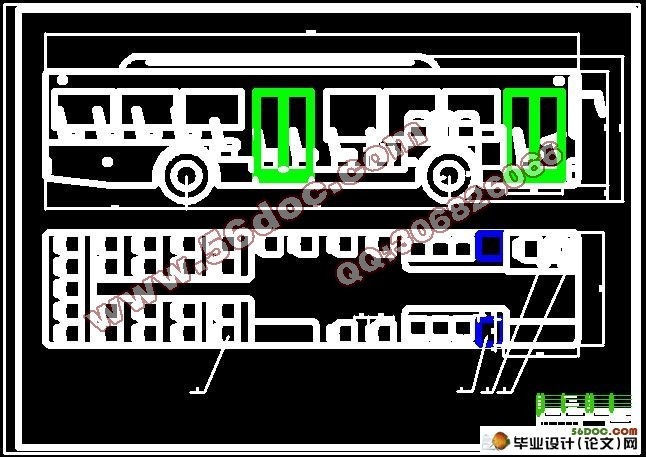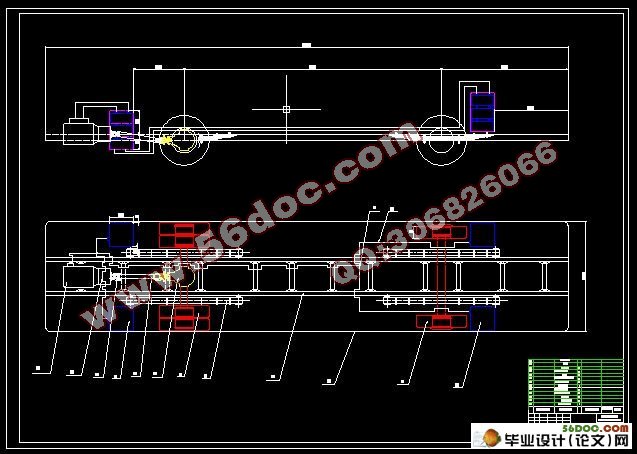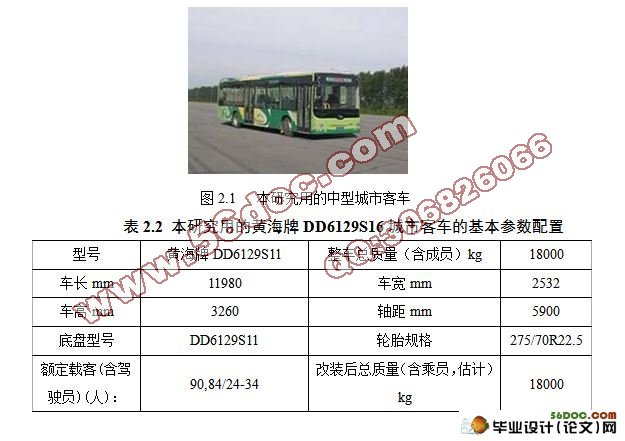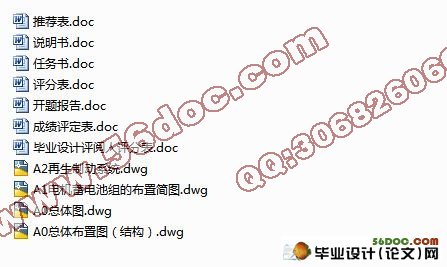城市纯电动公交车的总体设计
来源:wenku163.com 资料编号:WK1639285 资料等级:★★★★★ %E8%B5%84%E6%96%99%E7%BC%96%E5%8F%B7%EF%BC%9AWK1639285
资料介绍
城市纯电动公交车的总体设计(任务书,开题报告,毕业论文说明书25000字,CAD图纸4张)
摘 要
随着能源问题和环境问题的日益突出,现有车辆使用的动力方式已经不能很好的适应未来社会发展的需要。为此,电动汽车的发展得到了广泛的关注,各种类型的电动汽车也在研究和开发之中。
本研究的目的就是为了积累电动客车相关方面的技术,主要对电动汽车进行了总体设计研究,其中包括:分析了部分电动机的优缺点,选择永磁直流电动机作为动力源;对电动汽车的动力性进行了分析,通过最高车速、最大爬坡度和加速时间校核了电动机的性能;介绍了部分蓄电池的性能特点,选择铅酸蓄电池作为能量源;对电动机的控制策略进行了研究,提出蓄电池管理系统总体结构和各部分功能,并对蓄电池组电压、电流、温度和均衡充放电模块进行了总体设计研究;对整车再生制动的结构和控制进行了设计研究;讨论了电动汽车电动机及传动系统的结构和布置方案,设计了蓄电池组的布置位置和安放结构,同时对制动系统进行了初步改装设计。
关键词:纯电动汽车改装设计;电动机控制系统;蓄电池管理系统;再生制动
ABSTRACT
Being more and more serious along with the energy problems and the environmentproblems, the motive method of the existing vehicle used can't satisfy the demand of thesocial development in the future .For this, the development of EV gotten an extensive concern,various types of EV is also being in the research and the development.
The purpose of this research is to accumulated electric bus techniques.This researchmainly carried on a total design to the electric passenger car, the works are as follow:Ianalyzed the merit and shortcoming of some electric motors, and choosed the permanencemagnet DC motor to be the motive source;analyzed the motive of the electric passenger car,examine the performance of the electric motor;introduced the function characteristics of somestorage batteries, and choosed the Lead-acid storage battery to be the energy source;study thecontrol strategy of the electric motor, put forward total structure of the storagebattery management system and each parts of functions, and carried on a design and researchto each part; designed the structureand the control of the regenerative braking system; discussed electric motor and transmissionto equip of constitute and the decoration project, designed the decoration position of thestorage battery set and install structure, in the meantime first step to design a refit project ofthe the brake system, to carryon.
Keywords: EV Refit;Motor Drive System;Battery Management System;Regenerative Braking
主要内容:
1 研究电动汽车电动机的特点,并分析电动客车的动力性
2 研究电动客车的控制策略
3 分析电动汽车蓄电池性能特点及存在问题,设计蓄电池管理系统
4 研究纯电动汽车能量回收原理,设计再生制动系统的结构
5 设计电动客车总体布置图
技术要求:
1 研究电动汽车电动机的特点,并分析电动客车的动力性
2 研究电动客车的控制策略,并设计蓄电池管理系统
3 研究纯电动汽车能量回收原理,设计再生制动系统的结构
4 设计电动客车电机与传动系统机构布置、蓄电池组的布置、安装设计及电动汽车总体布置图




目 录
摘要………………………………………………………………………………………Ⅰ
Abstract……………………………………………………………………………………Ⅱ
第1章 绪论………………………………………………………………………………1
1.1本设计的背景及意义………………………………………………………………1
1.1.1当今内燃机汽车带来的问题………………………………………………1
1.1.2 电动汽车的优点……………………………………………………………2
1.1.3我国发展城市纯电动公交客车的优势……………………………………3
1.2 国内外电动汽车的现状及发展……………………………………………………3
1.2.1 世界电动汽车的发展历史溯源……………………………………………3
1.2.2 世界电动汽车近三十年的发展……………………………………………4
第2章 电动汽车电机技术……………………………………………………………5
2.1电动汽车电机的分类及特点………………………………………………………5
2.2电动汽车对电机性能的要求………………………………………………………7
2.3电动机驱动控制策略………………………………………………………………8
2.3.1电动汽车的电机驱动控制策略分析…………………………………………8
2.3.2电机与驱动控制……………………………………………………………9
2.4本设计用电动机……………………………………………………………………9
2.5电动机性能计算……………………………………………………………………9
2.5.1电动车的使用情况及性能选择……………………………………………9
2.5.2电动汽车的动力性…………………………………………………………10
2.5.3 电动机校核…………………………………………………………………11
2.6本章小结……………………………………………………………………………13
第3章 蓄电池技术及其管理系统设计……………………………………………14
3.1电池技术……………………………………………………………………………14
3.2蓄电池的分类及特点………………………………………………………………14
3.3蓄电池存在的问题…………………………………………………………………17
3.4电池管理技术………………………………………………………………………18
3.5电池管理系统的组成原理 ………………………………………………………20
3.6本研究用蓄电池 …………………………………………………………………21
3.7本章小结 …………………………………………………………………………22
第4章电动汽车能量回收及再生制动系统………………………………………23
4.1再生制动能量回收的重要性 ……………………………………………………23
4.2电动汽车制动过程的能量转换及其制动模式 …………………………………23
4.3制动能量回收的原则和约束条件 ………………………………………………23
4.4汽车再生制动原理 ………………………………………………………………24
4.5制动能量回收系统控制策略 ……………………………………………………24
4.5.1再生制动力的分配原则 …………………………………………………24
4.5.2制动系统的控制策略 ……………………………………………………26
4.6再生制动系统的结构设计 ………………………………………………………28
4.7本章小结 …………………………………………………………………………28
第5章 电动客车的总体设计………………………………………………………29
5.1电动客车的改装…………………………………………………………………29
5.2 改装布置设计注意事项…………………………………………………………29
5.3本设计所采用的方案……………………………………………………………30
5.4蓄电池组的布置…………………………………………………………………30
5.4.1蓄电池组布置的要求………………………………………………………30
5.4.2 蓄电池组布置位置…………………………………………………………31
5.5本章小结…………………………………………………………………………31
结论………………………………………………………………………………………33
参考文献 ………………………………………………………………………………34
致谢………………………………………………………………………………………36
|









